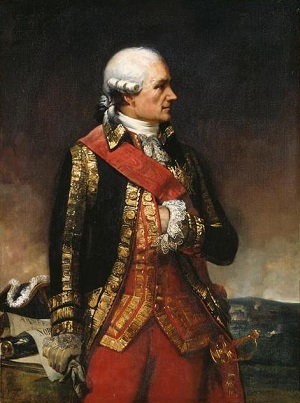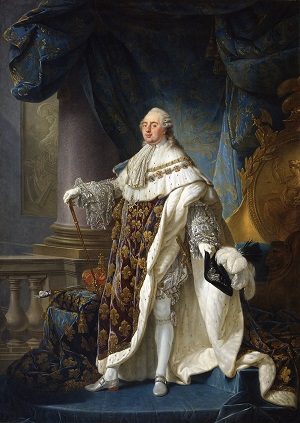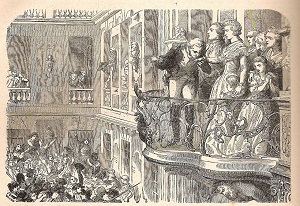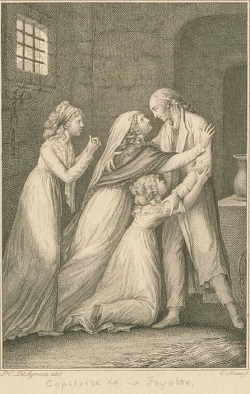Lafayette requested and was granted permission to return to France, arriving in February 1779, whereupon he was immediately arrested for having disobeyed the king, though he was hardly severely punished, serving only eight days under house arrest in a hotel. King Louis XVI soon forgave the Marquis for his transgression, and shortly after his arrival, Benjamin Franklin's grandson presented him with a gold encrusted sword — a show of appreciation from a grateful Continental Congress
On June 12, 1779, Lafayette wrote a long letter to Washington, expressing his desire to help the American revolutionary cause:
France has incurred great expenses lately. The Spaniards will not easily give their dollars. However, Dr. Franklin has got some money to pay the bills of Congress, and I hope I shall determine the government to greater sacrifices. Serving American is to my heart an inexpressible happiness.
So insistent was Lafayette for aid to the Americans that one day Count de Maurepas said in the royal council: "It is fortunate for the King, that Lafayette does not take it into his head to strip Versailles of its furniture, to send to his dear Americans; as his Majesty would be unable to refuse it." In addition to procuring support from the French government, Lafayette personally purchased a large amount of supplies for the troops he would command on his return to America.

Jean-Baptiste-Donatien de Vimeur, Comte de Rochambeau, Marechal De France (1725-1807)
Charles-Philippe Larivière, 1834
France continued to send both officers and troops to aid the American cause. In 1780, Count de Rochambeau was appointed commander of 7,000 French troops who were dispatched to America. Lafayette again offered his services, sailing on the French frigate Hermione on March 19, 1780. Rochambeau and his expedition arrived in Newport on July 10.
In the early fall of 1781 Cornwallis and his troops were driven into Yorktown, Virginia. Surrounded by French and American forces on the ground, and with a powerful French navy cutting off escape by sea, Cornwallis surrendered on October 19, 1781. While the war would not officially end for well over a year, the crushing defeat of the British at Yorktown was celebrated by the French and Americans as an all-but-final victory.
Lafayette again requested permission to return to France. Congress granted the request, giving him a letter of appreciation for his invaluable services. Before he sailed for home Washington wrote him a personal letter in which he said:
I owe it to your friendship and to my affectionate regard for you, my dear Marquis, not to let you leave this country without carrying with you fresh marks of my attachment to you, and new expressions of the high sense I entertain of your military conduct and other important services in the course of the last campaign, although the latter are too well known to need the testimony of my approbation.
On December 23, 1781, Lafayette sailed home from Boston on the frigate Alliance, bidding farewell to his beloved Commander in a letter:
Adieu, my dear General; I know your heart so well that I am sure that no distance can alter your attachment to me. With the same candour I assure that my love, respect, my gratitude for you, are above expression; that, at the moment of leaving you, I felt more than ever the strength of those friendly ties that forever bind me to you."
In 1784 he visited America on Washington's invitation, and was enormously popular as he travelled through each of the United States, returning again to France in 1785. In 1789 he was a representative for the nobility in the Estates General. By 1789, revolutionary fever was spreading throughout France. Lafayette was named the commander of the National Guard. On October 5, a hungry Parisian mob descended on the palace of Versaille, demanding bread. Lafayette's charisma and his well-established sympathy with the common people helped to calm the crowd and allay their anger for the royal family. As the crowd shouted angrily at the unpopular queen, Marie Antoinette, Lafayette kissed her hand on a balcony. Lafayette's charm may well have saved the king and queen on that day, though they would not, of course, survive the revolution.
As a nobleman who supported democratic ideals, he walked a thin line between two increasingly hostile camps. He had himself written the celebrated Declaration of the Rights of the Man and of the Citizen, but he did not support the complete overthrow of the established order, including the removal (and eventual execution) of the king.
In 1792, when war was declared with Austria, he took command of one of the three French Armies. He was captured and held prisoner until 1797. Lafayette reached out to his friends in the United States, including Washington and Jefferson. While the U.S. owed the Frenchman a great debt, they were unable to secure his release, though they did send money to make his incarceration more tolerable.
Lafayette returned home in 1797, his release negotiated by Napolean Bonaparte, at the time a powerful general, but soon, dictator of France. When the news of Washington's death reached France early in 1800, Napoleon held a memorial service for Washington at Invalides, but Lafayette was not invited and Napoleon ordered the orator not to refer to Lafayette in his oration.
To the end of his life Lafayette held firm for representative government in his country. The great general died in 1834. His tireless work for American independence will never be forgotten and his name will always shine out on the pages of our history.






